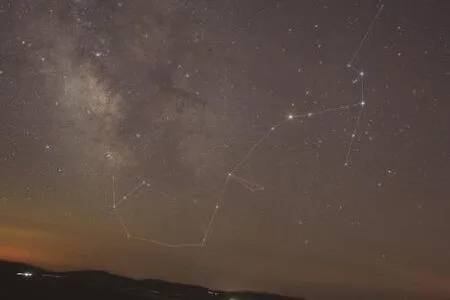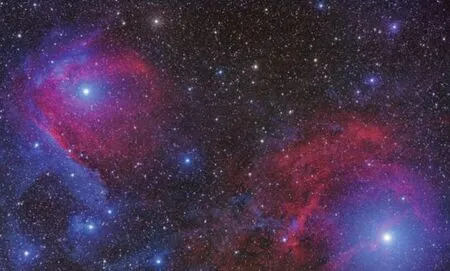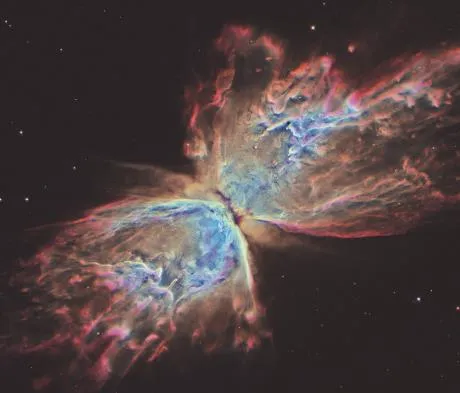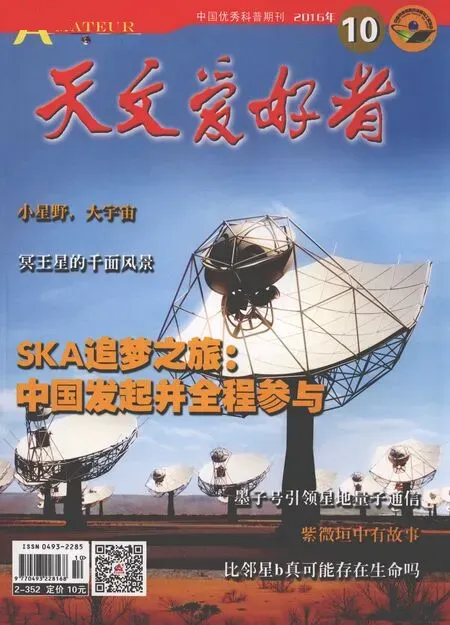双语小知识(四)
2016-02-11□曹燕
□ 曹 燕
双语小知识(四)
□ 曹 燕
The Stinger 尖刺
The celestial scorpion has a potent stinger. The two stars at the end of its tail — the stars that mark the stinger — are bright, big, and heavy. And at least one of them is likely to suffer a sting of its own: it’ll explode as a supernova. In fact, it may explode twice.
天空中的蝎子有着强有力的尖刺。天蝎座尾巴尖儿上的两颗星——两颗标志着尖刺的恒星——它们明亮、巨大而沉重。至少,它们中的一颗很可能忍受着它自己的叮咬:它将以超新星的形式爆发。实际上,它很可能会爆发两次。
The stars are known as Lambda and Upsilon Scorpii. Lambda is the brighter of the two, with Upsilon close to the right.
这两颗恒星也被称为尾宿八和尾宿九。尾宿八是两者中更亮的一颗,尾宿九紧邻其右。
Upsilon is perhaps 10 or 11 times the mass of the Sun — quite hefty by stellar standards. And Lambda consists of at least three stars. The main star is a little heavier than Upsilon, while another is quite similar to Upsilon.
尾宿九可能10或11倍于太阳质量——这对于恒星的标准来讲是非常重的。尾宿八至少由三颗恒星组成。主星比尾宿九稍微重一些,而另一颗和尾宿九接近。
The stars of the stinger are probably just 10 million to 15 million years old — a tiny fraction of the age of the Sun. Yet they’re already nearing the ends of their lives. As they get closer to the end, they’ll puff up, getting much bigger and brighter.
尖刺上的恒星们大约有1000万到1500万岁了——这与太阳年龄相比微不足道。尽管如此,它们已接近生命的尽头了。当行将就木时,它们会膨胀起来,变得更大、更亮。

2011年7月底摄于坝上草原的天蝎座照片,图片拍摄:李昕。
Before long, though, each star will reach a stage where it can no longer produce nuclear reactions in its core. The core will collapse. Then, if the star is heavy enough, its outer layers will blast into space, forming a titanic explosion known as a supernova.
不久之后,每颗恒星都将面临内核不能继续进行核反应的阶段。内核将坍塌。之后,如果恒星足够重,它的外层将向宇宙空间爆炸,形成被称为超新星的巨大爆炸。
That’s almost certainly the fate of the brighter star of Lambda Scorpii. And depending on their exact masses, it could also be the fate of Lambda’s other bright star, and of Upsilon as well— creating a series of blasts that could briefly increase the“sting” of the scorpion.
这几乎是尾宿八中较亮的恒星不可逃避的命运。基于确切质量,这可能也是尾宿八其他亮星的命运,尾宿九也是一样——产生能够短时间加强天蝎“尖刺”的一系列爆炸。
Delta Scorpii 房宿三
Delta Scorpii is an intriguing system. Its main star is only about 10 million years old — a mere infant on the stellar timescale. Yet it’s also about 13 times as massive as the Sun. Such heavy stars “burn” their nuclear fuel in a hurry, so they age much faster than smaller stars. So Delta Scorpii’s main star is already nearing the end of its normal lifetime.
房宿三是一个迷人的系统,其主要恒星的年龄只有大约1000万岁——这在恒星的时间坐标里只不过是一个小婴儿。尽管如此,它也有大约13倍于太阳的质量。如此之重的恒星极速“燃烧”它们的核燃料,因而它们比个头儿小的恒星“老”得快。也因为如此,房宿三的主星也接近它正常寿命的尽头。

在宇宙尘埃云的映衬下,房宿三(右侧稍低的那颗)显得格外炫目。图片来源:NASA,John Davis
The star is spinning rapidly, so it’s throwing off a lot of hot gas, which cools and condenses to make tiny grains of dust. These grains form a disk that’s at least 125 million miles wide.
这颗恒星正在高速旋转,所以正在抛出很多能够冷却、浓缩成细小尘埃颗粒的炽热气体。这些颗粒形成至少1.25亿英里宽的盘。
The star and a companion follow an elongated orbit around each other. At their closest, they almost touch. That appears to cause the system to flare brightly. In fact, during the two most recent encounters, Delta Scorpii jumped to almost twice its normal brightness.
这颗恒星和它的伙伴沿着被拉长的轨道绕彼此运转。在它们最接近的时候,它们几乎可以相触碰。这就导致系统出现了明亮的耀斑。实际上,在最近两次碰面时,房宿三飙升到正常亮度的近2倍。
Over the next few million years, the main star will puff up to enormous proportions, so it’ll shine many times brighter still. After that, it’s likely to explode as a supernova— briefly giving the scorpion a big head.
几百万年之后,这颗主要恒星将肿胀到非常巨大的规模,所以它将会变亮许多倍。在此之后,它可能会爆炸成一颗超新星——短暂地给予天蝎一颗硕大的头颅。
Butterfly Nebula蝴蝶星云
The scorpion is one of the most unappealing creatures on the planet. The celestial scorpion, however, offers one of the most appealing creatures in the galaxy: the Butterfly Nebula. This amazing structure emerged from its cocoon about 2,000 years ago as seen from Earth. Today, its colorful wings spread across more than two light-years.
蝎子是全世界最不能打动人的生物了。但是,天空中的天蝎座却提供了银河系最引人入胜的生物之一:蝴蝶星云。从地球上看,这一令人赞叹的构造在2000年前破茧而出。现在,它色彩斑斓的翅膀漫卷了超过2光年的距离。
The “wings” are big bubbles of gas and dust. They once formed the outer layers of a star that was heavier than the Sun. The star’s hot but dead core sits at the center of the nebula.
“翅膀们”是气体和尘埃组成的巨大泡泡。它们曾经组成了一颗比太阳还重的恒星外层。那颗恒星炽热但没有生命力的内核居于星云的中心位置。
Until the last couple of thousand years, the core generated energy through nuclear fusion. Today, though, that process has stopped. The leftover core, which is about two-thirds as massive as the Sun, shines perhaps 2,000 times brighter than the Sun. And its surface is hundreds of thousands of degrees hotter than the Sun’s.
直到最近几千年,内核以核聚变的方式发出能量。当然,如今,这一进程停止了。残余的内核,大约有太阳的三分之二那么多质量,发出了比太阳亮大约2000倍的光。它的表面也比太阳热成千上万度。

展开翅膀的蝴蝶绚丽夺目。图片来源:NASA, ESA, 以及哈勃SM4 ERO团队,后期制作及版权:Francesco Antonucci
But the dying core may be fading by as much as one percent per year. And it will continue to cool and fade rapidly over the next few millennia. At the end of that time, the core will be a white dwarf — a dense ball not much bigger than Earth. By then, the surrounding butterfly will begin to fade, destroying a bit of beauty in the celestial scorpion.
但是,将死的内核可能以大概每年百分之一的速度衰退。在未来的几千年里,它将继续变冷并迅速衰退。到最后,内核将变成白矮星——一个密度很高但比地球大不了多少的圆球。届时,围绕它的蝴蝶将开始凋零,绽放于天蝎中的美丽将被摧毁。
特别说明:以上三篇文稿英文撰稿均为DamondBenningfield。文章来源于Star Date网站(https://stardate.org/),欢迎大家关注网站查看原文。
